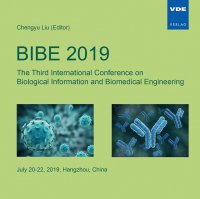Microwave-induced thermoacoustic tomography for whole-body neonatal mouse imaging
Konferenz: BIBE 2019 - The Third International Conference on Biological Information and Biomedical Engineering
20.06.2019 - 22.06.2019 in Hangzhou, China
Tagungsband: BIBE 2019
Seiten: 5Sprache: EnglischTyp: PDF
Persönliche VDE-Mitglieder erhalten auf diesen Artikel 10% Rabatt
Autoren:
Zhao, Yuan; Chi, Zihui; Huang, Lin (School of Electronic Science and Engineering, University of Electronic Science and Technology of China, Chengdu, China & Center for Information in Medicine, University of Electronic Science and Technology of China Chengdu, China)
Shan, Tianqi (Department of Biomedical Engineering, University of Florida, Gainesville, Florida, USA)
Jiang, Huabei (School of Electronic Science and Engineering, University of Electronic Science and Technology of China, Chengdu, China & Center for Information in Medicine, University of Electronic Science and Technology of China Chengdu, China & Department of Medical Engineering, University of South Florida, Tampa, Florida, USA)
Inhalt:
Mouse is an ideal animal model for phenotyping. However, current methods available for in-vivo whole-body imaging of mouse embryos and newborns lack the ability to provide electrical properties of internal tissue with high temporal resolution. Microwave-induced thermoacoustic tomography (TAT) combines deep penetration depth of microwave with high resolution of ultrasonic imaging, which is a novel non-invasive imaging modality for mapping the electrical properties of tissue. In this study, for the first time, a cylindrical-scanning TAT system was developed with optimized microwave irradiation and ultrasound detection for whole-body neonatal mouse imaging. And its potential in visualizing the internal organs and structures of neonatal mice was evaluated by comparing with corresponding frozen histological photographs. The results demonstrated that TAT can noninvasively visualize the boundary and internal structures of newborns mice based on electrical properties of tissue, which could provide complementary information to magnetic resonance imaging (MRI) as it delivers a novel tissue contrast, which is very different from other modalities.


